Arthritis is an umbrella term for more than 100 conditions that affect the joints and surrounding structures in our body. It’s one of the most common, costly and disabling chronic conditions in the world.
The three main kinds of arthritis are osteoarthritis (OA), rheumatoid arthritis (RA), and psoriatic arthritis (PsA). Each type develops differently, but all are painful and can lead to loss of function and deformity.
Therefore, in this blog post, we are going to share with you some healthy habits you can practice to reduce your risk of developing arthritis as you get older.
1. Don’t get injured
As time goes by, your joints can start to exhaust. But when you injure your joints — for example, while playing sports or due to an accident — you can damage the cartilage and make it exhaust faster.
To avoid injury, do always use the proper safety equipment while playing sports, and learn the correct exercise techniques.
2. Consume fish
In accordance with The United States Department of Agriculture (USDA), eating fish that are high in omega-3s — like salmon, trout, mackerel, and sardines — twice a week can reduce your risk of developing rheumatoid arthritis. Omega-3 fatty acids have a healthy polyunsaturated fat and a number of health benefits, and they can reduce inflammation in the body.
Fish caught in the wild is usually recommended over farmed fish.
3. Keep your weight under control
With reference to Johns Hopkins, if you’re just 10 pounds overweight, the force on your knee as you take each step increases by 30 to 60 pounds. Being overweight or obese can take a real toll on your knees.
Overweight women are almost four times more likely to get knee osteoarthritis than women of a healthy weight. Diet and exercise can help bring your weight into a healthier range.

4. Physical exercise
Exercise not only takes the stress of excess weight off your joints, but also strengthens the muscles around the joints. This stabilizes them and can protect them from added wear and tear.
To maximize the benefits of your exercise program, alternate aerobic activities such as walking or swimming with strengthening exercises. Also, add in some stretching to maintain your flexibility and range of motion.
5. Keep your joints safe
Using the right techniques when sitting, working, and lifting can help protect joints from everyday strains. For example, lift with your knees and hips — not your back — when picking up objects.
Carry items close to your body so you don’t put too much strain on your wrists. If you have to sit for long periods of time at work, make sure that your back, legs, and arms are well supported.
6. Give your doctor a visit
If you do begin to develop arthritis, see your doctor or a rheumatologist. The damage from arthritis is usually progressive. This means the longer you wait to seek treatment, the more destruction can occur to the joint.
Your doctor may be able to suggest treatments or lifestyle interventions that can slow the progress of your arthritis and preserve your mobility.
Takeaway
Having arthritis may mean that you need to take some steps to prevent pain or manage stiffness, but it doesn’t necessarily mean you have to have surgery or other invasive treatments. Many people take steps to manage their arthritis and prevent the condition from worsening. Often, with some simple treatment and prevention steps, people with arthritis can learn to manage symptoms so that they can remain in control.


